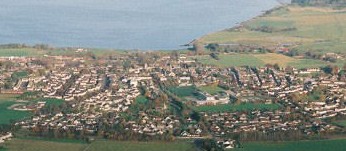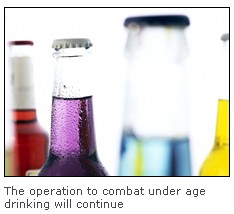 Related Articles
Related Articles
|
|
|
 Websites
Websites
|
|
|
|
|
'Curfews' in the Highlands
Watchman reports on the rising levels of public disorder in the Highand capital which is invoking serious responses from the authorities
 I HAVE never (before or since) been so close to calling on the police for personal protection. The occasion was an early evening visit to a corner store in Hamilton in the summer of 1997 (and before mobile phones had arrived). I HAVE never (before or since) been so close to calling on the police for personal protection. The occasion was an early evening visit to a corner store in Hamilton in the summer of 1997 (and before mobile phones had arrived).
I should say that the personal safety that I was concerned about was not my own, but rather that of the local shopkeeper who was being faced up with a group of the most aggressive youngsters demanding alcohol from him. The situation was explosive, and the sense of imminent violence most palpable. In the event, the highly-nervous shopkeeper managed to diffuse the situation – but only just.
The Hamilton Curfew
Following that most worrying incident I tracked a ‘teen curfew’ initiative by the Hamilton police through reports in the national press. As far as I can remember the scheme was set up to monitor young people out on the streets after dark, and – beyond a certain hour – for police officers to return them to their homes.
In the progress of the scheme and subsequent evaluation it transpired that when the police turned up at the respective homes with their charges, they found one of three situations pertaining: these being –
• the parents were at home but having a drinking party themselves and didn’t want the children there
• the parents were out of the house(s) themselves
• the parents received their children from the police at the front door and then, immediately the patrol car was out of sight, let them out of the back door onto the street again
So it seemed that alongside the behaviour of the youngsters on the streets – and some were very young indeed – a large part of the problem was the way that they were being looked after and controlled (or not) by their parents.
And now in the Highlands and Islands
In a traditionally law-abiding part of Scotland, a steep rise in juvenile crime is a symptom of something going awry that must be taken seriously.
|
After a year or so I lost track of the scheme. But it has now – in April 2009 – reappeared in both national and local media: only this time it is not Hamilton but Inverness. It is being currently reported that in the Highland capital youth referrals have risen by 15% since 2006, and have prompted Northern Constabulary to ask for powers to take a 'slightly different approach'.
It wants to be able to impose a curfew on individual young people under 16 who repeatedly commit crime or cause a nuisance. One piece of national coverage observes: ‘In a traditionally law-abiding part of Scotland, a steep rise in juvenile crime is a symptom of something going awry that must be taken seriously. When the crimes include violence and sexual offences, they cannot be dismissed as bad behaviour that has got out of hand.’ |
Highland GP needs police protection
 The problem of violence and crime are now escalating nationally, and behaviour which was previously and mainly confined to the toughest of inner-city areas is now manifest in Highland communities. A local (male) GP in a fairly small – and previously peaceful – Highland township will not now attend out-of-hours call outs without police protection. The problem of violence and crime are now escalating nationally, and behaviour which was previously and mainly confined to the toughest of inner-city areas is now manifest in Highland communities. A local (male) GP in a fairly small – and previously peaceful – Highland township will not now attend out-of-hours call outs without police protection.
The problem is now 2 – 3 generations old. Lack of respect and discipline flows directly from the rampant liberalism that has pervaded all areas of public life and resulted in even grandparents (many of whom are just in their 30s due to the increase in teenage pregnancies) lacking the personal experience and skills to operate a healthy parenting regime.
The problem will not go away; and indeed is set to get worse as – and this is the other side of the liberal coin – some parents, including the wife of one health professional in a Highland community, are frightened to discipline their children lest the latter report their parents to the police and social services.
A two-way approach
The remedy is two-fold and it doesn’t involve stigmatising and/or criminalising parents and youngsters – indeed both groups are, to a degree, ‘victims’.
But the cycle of socially unacceptable – including criminal and violent – behaviour will not be cured without structured intervention and changes to public policy.
 The environment in which young people are growing up today is that of an ‘anything goes’ culture. Pornography, and extreme and graphic violence are the very stuff of much of the film, TV, magazine and internet scene. The environment in which young people are growing up today is that of an ‘anything goes’ culture. Pornography, and extreme and graphic violence are the very stuff of much of the film, TV, magazine and internet scene.
Alcohol is often cheaper than bottled water and – despite checks at retail outlets – easily available.
With respect to drugs, illicit and dangerous ‘substances’ are also freely available and affordable. Not only that, but the social acceptability of drug use has continued to rise partly due to the ‘So what?’ throw away comments by high-profile personalities and public figures coupled with confusion over classification.
As far as parenting is concerned, it is the most difficult and responsible job that anyone will ever be called to do. And yet it is the task which the vast majority of parents receive no training whatsoever. So the only thing that any new parent has to draw from is their own experience of being parented themselves. Very sadly, in many cases, this is not an example that can be commended – as the results of the Hamilton curfew illustrated.
The Missing Dimension
Meanwhile, the welfare benefit system in the UK encourages the youngest of children to become parents themselves, and through public health policies which oblige schools to teach ‘sex education’ which is devoid of any moral input is fostering the exorbitant rise in teenage (even now primary school) pregnancies, abortion, single-parenting (Note 1.), absent fathers, sexually-transmitted infections and related health problems like cervical cancer.
Poor parenting has been identified time and time again as a major factor in anti-social behaviour, young offending, teenage pregnancies, non-attending, poor education and employment prospects.
The health, social services and police cannot cope with all of this; and neither in fact can the country as a whole. Until there is an acknowledgement that present policies have failed to stem the tide, the UK is set to continue on a spiral of rapidly-rising public disorder and crippling human, social and economic cost.
Whether we like it or not, today’s young people are a product of a social environment which those of who have gone before have created. The problems can only be tackled at a level which transcends local and national party politics; and will continue to defy resolution until there is an overt and accepted need for a moral framework in all areas of public and private life.
---------------
Note 1.
One Inverness dad (we'll call him John) went up to secondary school in 1975. At that time he was the only child in the class WITHOUT a mum and a dad at home and together.
When John's teenage son recently went into secondary in the same school, he was the only child in the class WITH two parents who were (are) still married and living together as a family.
Ed footnote:
You can add your comments by clicking on the green button below. If you wish to send this article on (e.g. to friends, colleagues or policy-makers) you can either -
- click on the
 link in the left hand margin of this page (scroll up) or - link in the left hand margin of this page (scroll up) or -
- copy and paste this URL into an e-mail - http://tinyurl.com/cosfzk
If you wish to send this article (as above) or write to your elected representatives use the link below to find their contact details. If you do use the links to send an e-mail, you will be sent an automatic e-mail after you have sent your message. You must respond to the automatic e-mail or your original message will not arrive.
|
Watchman, 16/04/2009
|
|
|
|